University of East London CR4001: Measuring Crime in Criminology
VerifiedAdded on 2022/11/28
|7
|2847
|129
Essay
AI Summary
This essay delves into the critical aspects of measuring crime within the field of criminology, emphasizing its importance for understanding criminal trends, the criminal justice system, and the effectiveness of public policies. The essay examines various data sources, including victim surveys, official police reports, and offender self-reports, highlighting their respective strengths and weaknesses. Focusing on the UK context, it describes the British Crime Survey and self-reported crime measures, detailing their methodologies and significance. Furthermore, the essay explores the challenges associated with each measurement method, such as data limitations, underreporting, and the impact of human factors. It then proposes enhancements for self-report surveys, including incorporating a wide array of delinquency items, screening for trivial behavior, and applying surveys to a wider age range. The essay also discusses the use of longitudinal designs and other strategies to improve the validity and reliability of crime measurement, ultimately aiming to provide a comprehensive understanding of the complexities involved.

Introduction to Criminology and Criminal Justice
MEASURING CRIME
MEASURING CRIME
Paraphrase This Document
Need a fresh take? Get an instant paraphrase of this document with our AI Paraphraser
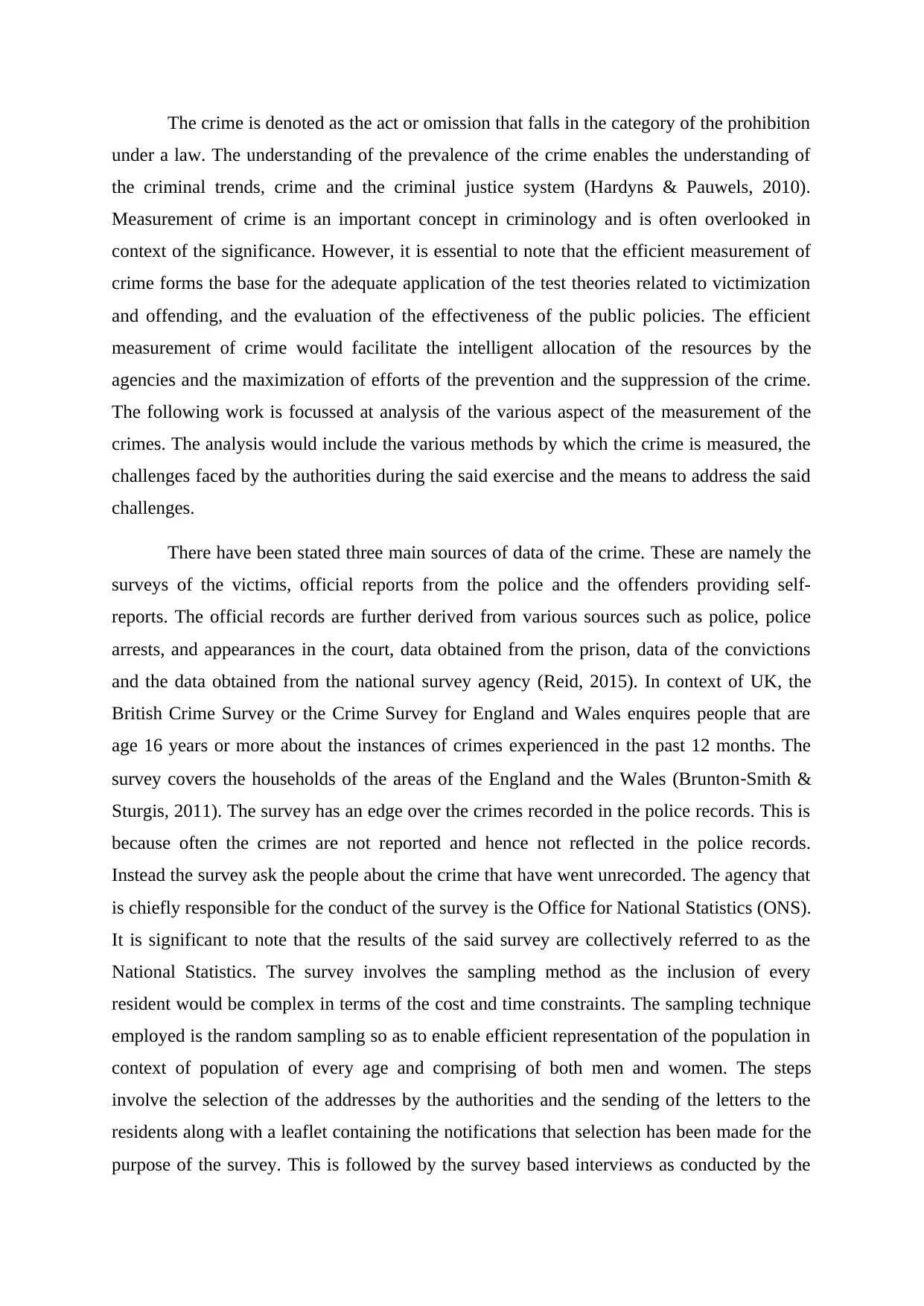
The crime is denoted as the act or omission that falls in the category of the prohibition
under a law. The understanding of the prevalence of the crime enables the understanding of
the criminal trends, crime and the criminal justice system (Hardyns & Pauwels, 2010).
Measurement of crime is an important concept in criminology and is often overlooked in
context of the significance. However, it is essential to note that the efficient measurement of
crime forms the base for the adequate application of the test theories related to victimization
and offending, and the evaluation of the effectiveness of the public policies. The efficient
measurement of crime would facilitate the intelligent allocation of the resources by the
agencies and the maximization of efforts of the prevention and the suppression of the crime.
The following work is focussed at analysis of the various aspect of the measurement of the
crimes. The analysis would include the various methods by which the crime is measured, the
challenges faced by the authorities during the said exercise and the means to address the said
challenges.
There have been stated three main sources of data of the crime. These are namely the
surveys of the victims, official reports from the police and the offenders providing self-
reports. The official records are further derived from various sources such as police, police
arrests, and appearances in the court, data obtained from the prison, data of the convictions
and the data obtained from the national survey agency (Reid, 2015). In context of UK, the
British Crime Survey or the Crime Survey for England and Wales enquires people that are
age 16 years or more about the instances of crimes experienced in the past 12 months. The
survey covers the households of the areas of the England and the Wales (Brunton‐Smith &
Sturgis, 2011). The survey has an edge over the crimes recorded in the police records. This is
because often the crimes are not reported and hence not reflected in the police records.
Instead the survey ask the people about the crime that have went unrecorded. The agency that
is chiefly responsible for the conduct of the survey is the Office for National Statistics (ONS).
It is significant to note that the results of the said survey are collectively referred to as the
National Statistics. The survey involves the sampling method as the inclusion of every
resident would be complex in terms of the cost and time constraints. The sampling technique
employed is the random sampling so as to enable efficient representation of the population in
context of population of every age and comprising of both men and women. The steps
involve the selection of the addresses by the authorities and the sending of the letters to the
residents along with a leaflet containing the notifications that selection has been made for the
purpose of the survey. This is followed by the survey based interviews as conducted by the
under a law. The understanding of the prevalence of the crime enables the understanding of
the criminal trends, crime and the criminal justice system (Hardyns & Pauwels, 2010).
Measurement of crime is an important concept in criminology and is often overlooked in
context of the significance. However, it is essential to note that the efficient measurement of
crime forms the base for the adequate application of the test theories related to victimization
and offending, and the evaluation of the effectiveness of the public policies. The efficient
measurement of crime would facilitate the intelligent allocation of the resources by the
agencies and the maximization of efforts of the prevention and the suppression of the crime.
The following work is focussed at analysis of the various aspect of the measurement of the
crimes. The analysis would include the various methods by which the crime is measured, the
challenges faced by the authorities during the said exercise and the means to address the said
challenges.
There have been stated three main sources of data of the crime. These are namely the
surveys of the victims, official reports from the police and the offenders providing self-
reports. The official records are further derived from various sources such as police, police
arrests, and appearances in the court, data obtained from the prison, data of the convictions
and the data obtained from the national survey agency (Reid, 2015). In context of UK, the
British Crime Survey or the Crime Survey for England and Wales enquires people that are
age 16 years or more about the instances of crimes experienced in the past 12 months. The
survey covers the households of the areas of the England and the Wales (Brunton‐Smith &
Sturgis, 2011). The survey has an edge over the crimes recorded in the police records. This is
because often the crimes are not reported and hence not reflected in the police records.
Instead the survey ask the people about the crime that have went unrecorded. The agency that
is chiefly responsible for the conduct of the survey is the Office for National Statistics (ONS).
It is significant to note that the results of the said survey are collectively referred to as the
National Statistics. The survey involves the sampling method as the inclusion of every
resident would be complex in terms of the cost and time constraints. The sampling technique
employed is the random sampling so as to enable efficient representation of the population in
context of population of every age and comprising of both men and women. The steps
involve the selection of the addresses by the authorities and the sending of the letters to the
residents along with a leaflet containing the notifications that selection has been made for the
purpose of the survey. This is followed by the survey based interviews as conducted by the
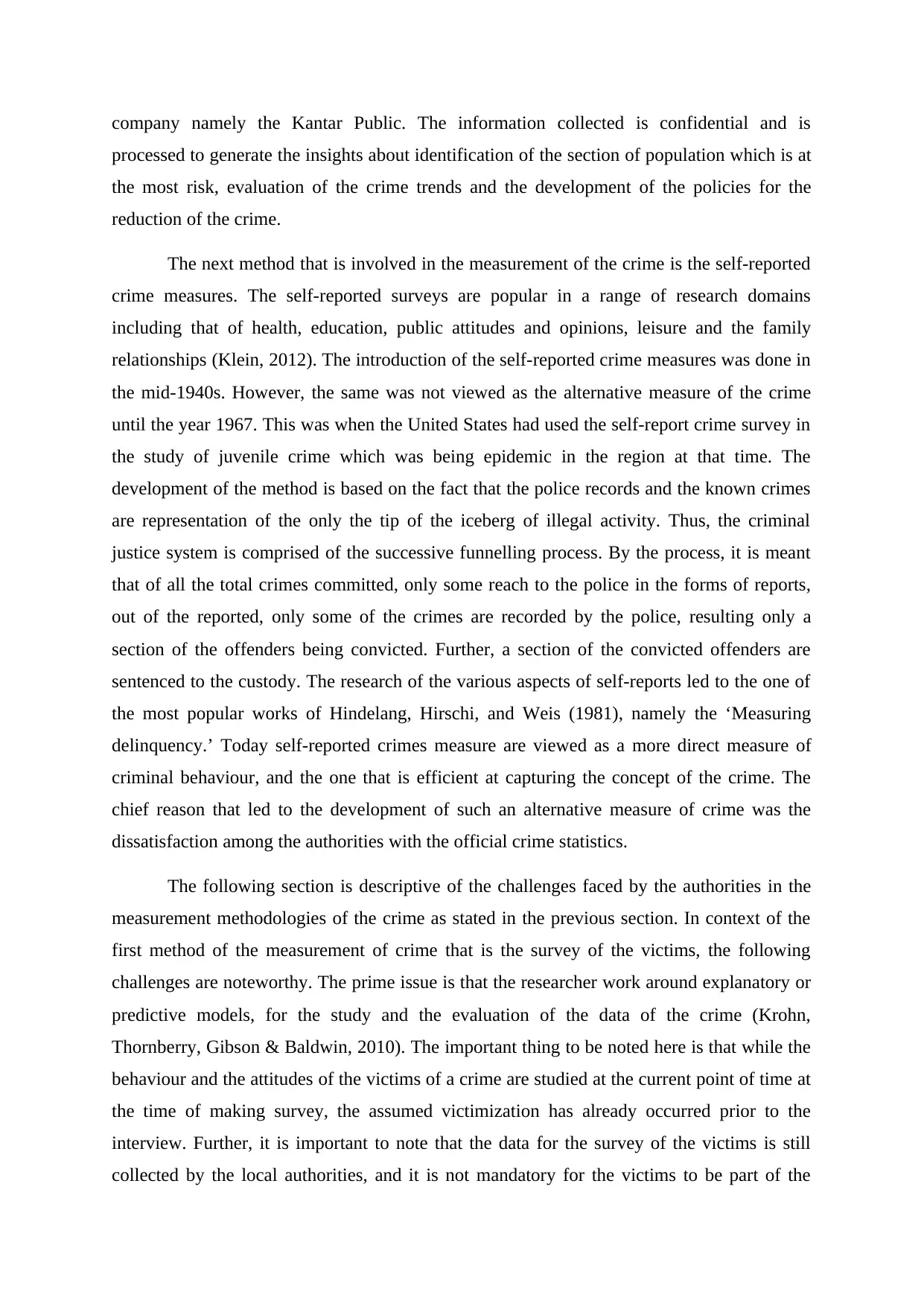
company namely the Kantar Public. The information collected is confidential and is
processed to generate the insights about identification of the section of population which is at
the most risk, evaluation of the crime trends and the development of the policies for the
reduction of the crime.
The next method that is involved in the measurement of the crime is the self-reported
crime measures. The self-reported surveys are popular in a range of research domains
including that of health, education, public attitudes and opinions, leisure and the family
relationships (Klein, 2012). The introduction of the self-reported crime measures was done in
the mid-1940s. However, the same was not viewed as the alternative measure of the crime
until the year 1967. This was when the United States had used the self-report crime survey in
the study of juvenile crime which was being epidemic in the region at that time. The
development of the method is based on the fact that the police records and the known crimes
are representation of the only the tip of the iceberg of illegal activity. Thus, the criminal
justice system is comprised of the successive funnelling process. By the process, it is meant
that of all the total crimes committed, only some reach to the police in the forms of reports,
out of the reported, only some of the crimes are recorded by the police, resulting only a
section of the offenders being convicted. Further, a section of the convicted offenders are
sentenced to the custody. The research of the various aspects of self-reports led to the one of
the most popular works of Hindelang, Hirschi, and Weis (1981), namely the ‘Measuring
delinquency.’ Today self-reported crimes measure are viewed as a more direct measure of
criminal behaviour, and the one that is efficient at capturing the concept of the crime. The
chief reason that led to the development of such an alternative measure of crime was the
dissatisfaction among the authorities with the official crime statistics.
The following section is descriptive of the challenges faced by the authorities in the
measurement methodologies of the crime as stated in the previous section. In context of the
first method of the measurement of crime that is the survey of the victims, the following
challenges are noteworthy. The prime issue is that the researcher work around explanatory or
predictive models, for the study and the evaluation of the data of the crime (Krohn,
Thornberry, Gibson & Baldwin, 2010). The important thing to be noted here is that while the
behaviour and the attitudes of the victims of a crime are studied at the current point of time at
the time of making survey, the assumed victimization has already occurred prior to the
interview. Further, it is important to note that the data for the survey of the victims is still
collected by the local authorities, and it is not mandatory for the victims to be part of the
processed to generate the insights about identification of the section of population which is at
the most risk, evaluation of the crime trends and the development of the policies for the
reduction of the crime.
The next method that is involved in the measurement of the crime is the self-reported
crime measures. The self-reported surveys are popular in a range of research domains
including that of health, education, public attitudes and opinions, leisure and the family
relationships (Klein, 2012). The introduction of the self-reported crime measures was done in
the mid-1940s. However, the same was not viewed as the alternative measure of the crime
until the year 1967. This was when the United States had used the self-report crime survey in
the study of juvenile crime which was being epidemic in the region at that time. The
development of the method is based on the fact that the police records and the known crimes
are representation of the only the tip of the iceberg of illegal activity. Thus, the criminal
justice system is comprised of the successive funnelling process. By the process, it is meant
that of all the total crimes committed, only some reach to the police in the forms of reports,
out of the reported, only some of the crimes are recorded by the police, resulting only a
section of the offenders being convicted. Further, a section of the convicted offenders are
sentenced to the custody. The research of the various aspects of self-reports led to the one of
the most popular works of Hindelang, Hirschi, and Weis (1981), namely the ‘Measuring
delinquency.’ Today self-reported crimes measure are viewed as a more direct measure of
criminal behaviour, and the one that is efficient at capturing the concept of the crime. The
chief reason that led to the development of such an alternative measure of crime was the
dissatisfaction among the authorities with the official crime statistics.
The following section is descriptive of the challenges faced by the authorities in the
measurement methodologies of the crime as stated in the previous section. In context of the
first method of the measurement of crime that is the survey of the victims, the following
challenges are noteworthy. The prime issue is that the researcher work around explanatory or
predictive models, for the study and the evaluation of the data of the crime (Krohn,
Thornberry, Gibson & Baldwin, 2010). The important thing to be noted here is that while the
behaviour and the attitudes of the victims of a crime are studied at the current point of time at
the time of making survey, the assumed victimization has already occurred prior to the
interview. Further, it is important to note that the data for the survey of the victims is still
collected by the local authorities, and it is not mandatory for the victims to be part of the
⊘ This is a preview!⊘
Do you want full access?
Subscribe today to unlock all pages.

Trusted by 1+ million students worldwide
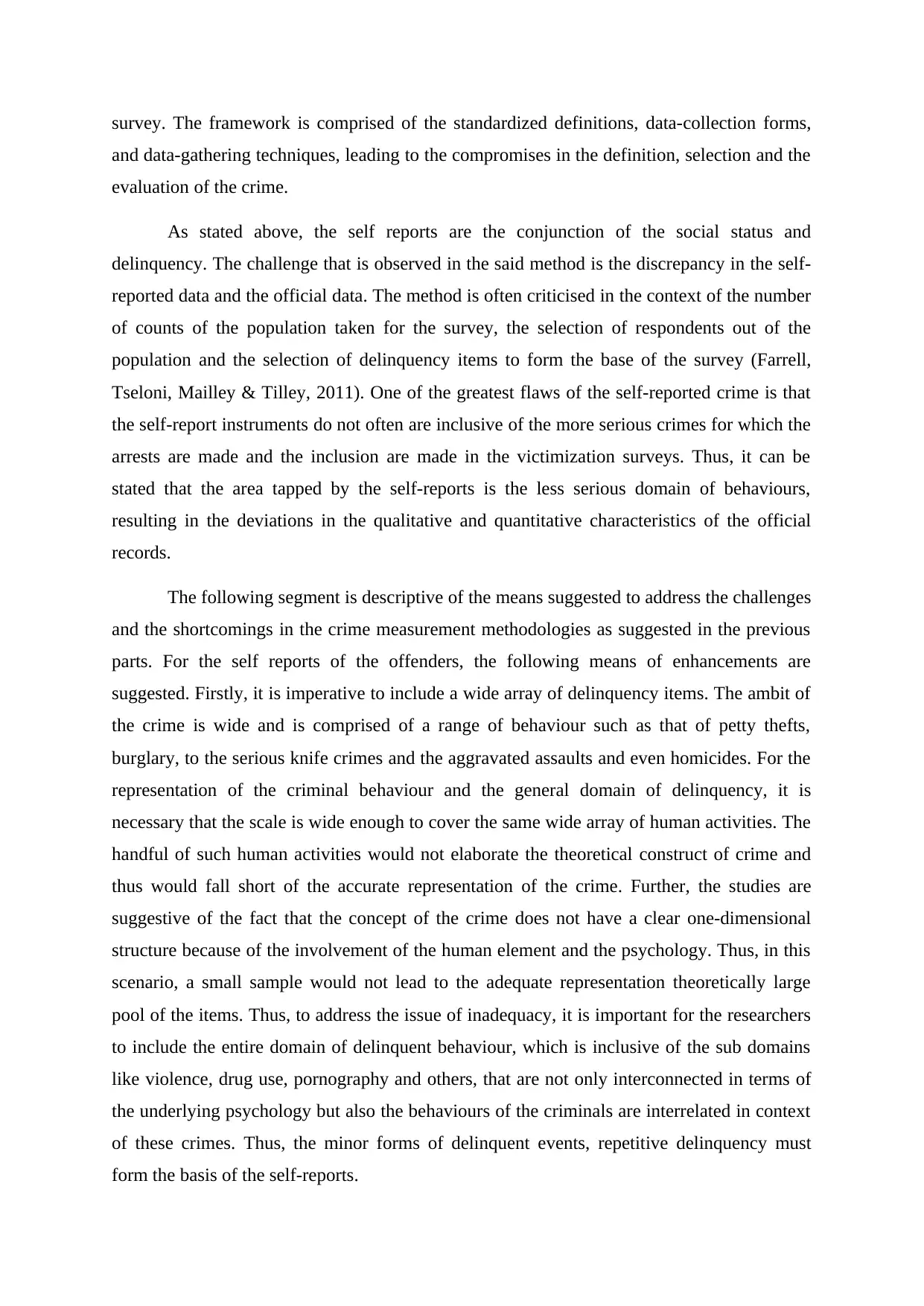
survey. The framework is comprised of the standardized definitions, data-collection forms,
and data-gathering techniques, leading to the compromises in the definition, selection and the
evaluation of the crime.
As stated above, the self reports are the conjunction of the social status and
delinquency. The challenge that is observed in the said method is the discrepancy in the self-
reported data and the official data. The method is often criticised in the context of the number
of counts of the population taken for the survey, the selection of respondents out of the
population and the selection of delinquency items to form the base of the survey (Farrell,
Tseloni, Mailley & Tilley, 2011). One of the greatest flaws of the self-reported crime is that
the self-report instruments do not often are inclusive of the more serious crimes for which the
arrests are made and the inclusion are made in the victimization surveys. Thus, it can be
stated that the area tapped by the self-reports is the less serious domain of behaviours,
resulting in the deviations in the qualitative and quantitative characteristics of the official
records.
The following segment is descriptive of the means suggested to address the challenges
and the shortcomings in the crime measurement methodologies as suggested in the previous
parts. For the self reports of the offenders, the following means of enhancements are
suggested. Firstly, it is imperative to include a wide array of delinquency items. The ambit of
the crime is wide and is comprised of a range of behaviour such as that of petty thefts,
burglary, to the serious knife crimes and the aggravated assaults and even homicides. For the
representation of the criminal behaviour and the general domain of delinquency, it is
necessary that the scale is wide enough to cover the same wide array of human activities. The
handful of such human activities would not elaborate the theoretical construct of crime and
thus would fall short of the accurate representation of the crime. Further, the studies are
suggestive of the fact that the concept of the crime does not have a clear one-dimensional
structure because of the involvement of the human element and the psychology. Thus, in this
scenario, a small sample would not lead to the adequate representation theoretically large
pool of the items. Thus, to address the issue of inadequacy, it is important for the researchers
to include the entire domain of delinquent behaviour, which is inclusive of the sub domains
like violence, drug use, pornography and others, that are not only interconnected in terms of
the underlying psychology but also the behaviours of the criminals are interrelated in context
of these crimes. Thus, the minor forms of delinquent events, repetitive delinquency must
form the basis of the self-reports.
and data-gathering techniques, leading to the compromises in the definition, selection and the
evaluation of the crime.
As stated above, the self reports are the conjunction of the social status and
delinquency. The challenge that is observed in the said method is the discrepancy in the self-
reported data and the official data. The method is often criticised in the context of the number
of counts of the population taken for the survey, the selection of respondents out of the
population and the selection of delinquency items to form the base of the survey (Farrell,
Tseloni, Mailley & Tilley, 2011). One of the greatest flaws of the self-reported crime is that
the self-report instruments do not often are inclusive of the more serious crimes for which the
arrests are made and the inclusion are made in the victimization surveys. Thus, it can be
stated that the area tapped by the self-reports is the less serious domain of behaviours,
resulting in the deviations in the qualitative and quantitative characteristics of the official
records.
The following segment is descriptive of the means suggested to address the challenges
and the shortcomings in the crime measurement methodologies as suggested in the previous
parts. For the self reports of the offenders, the following means of enhancements are
suggested. Firstly, it is imperative to include a wide array of delinquency items. The ambit of
the crime is wide and is comprised of a range of behaviour such as that of petty thefts,
burglary, to the serious knife crimes and the aggravated assaults and even homicides. For the
representation of the criminal behaviour and the general domain of delinquency, it is
necessary that the scale is wide enough to cover the same wide array of human activities. The
handful of such human activities would not elaborate the theoretical construct of crime and
thus would fall short of the accurate representation of the crime. Further, the studies are
suggestive of the fact that the concept of the crime does not have a clear one-dimensional
structure because of the involvement of the human element and the psychology. Thus, in this
scenario, a small sample would not lead to the adequate representation theoretically large
pool of the items. Thus, to address the issue of inadequacy, it is important for the researchers
to include the entire domain of delinquent behaviour, which is inclusive of the sub domains
like violence, drug use, pornography and others, that are not only interconnected in terms of
the underlying psychology but also the behaviours of the criminals are interrelated in context
of these crimes. Thus, the minor forms of delinquent events, repetitive delinquency must
form the basis of the self-reports.
Paraphrase This Document
Need a fresh take? Get an instant paraphrase of this document with our AI Paraphraser
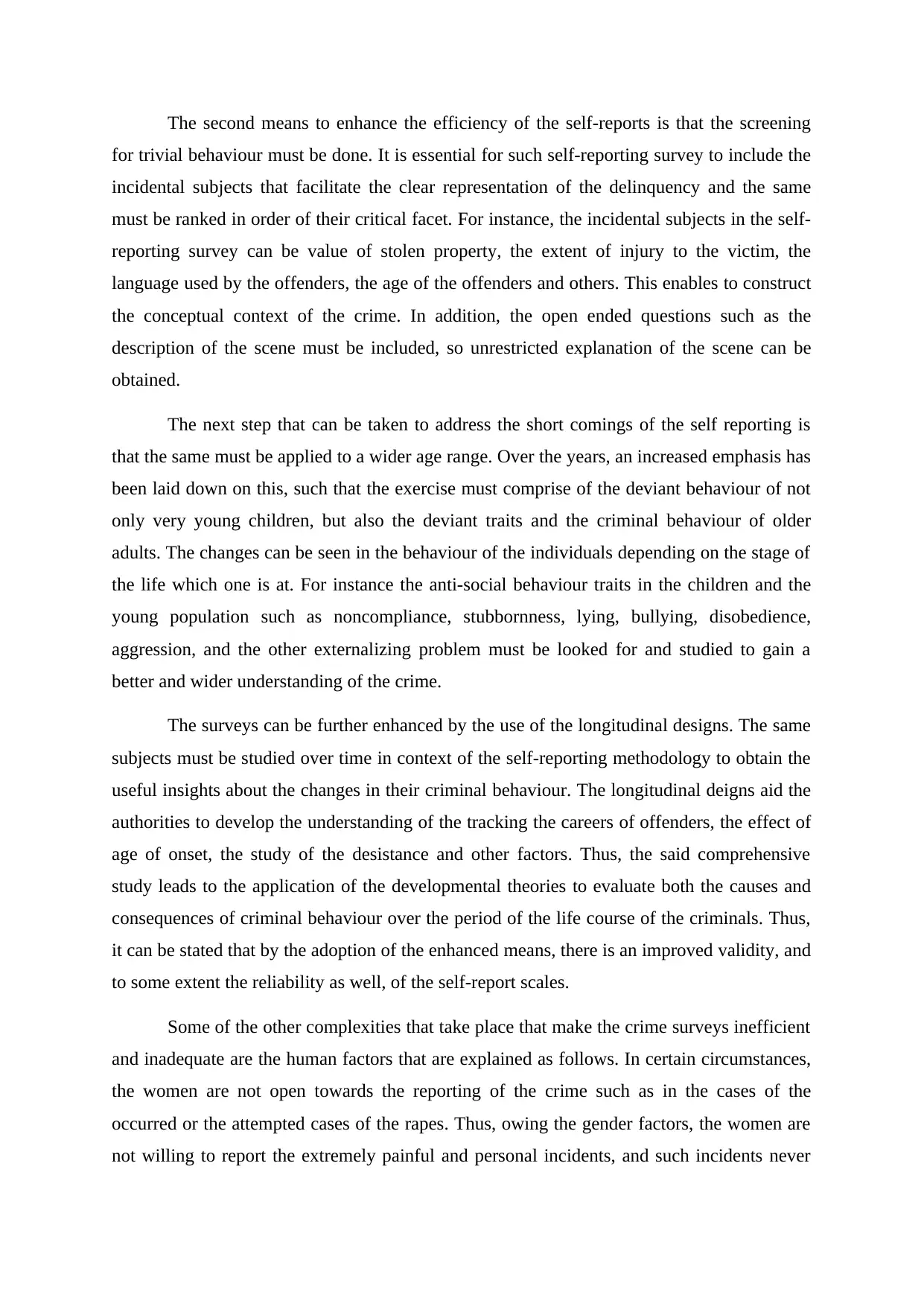
The second means to enhance the efficiency of the self-reports is that the screening
for trivial behaviour must be done. It is essential for such self-reporting survey to include the
incidental subjects that facilitate the clear representation of the delinquency and the same
must be ranked in order of their critical facet. For instance, the incidental subjects in the self-
reporting survey can be value of stolen property, the extent of injury to the victim, the
language used by the offenders, the age of the offenders and others. This enables to construct
the conceptual context of the crime. In addition, the open ended questions such as the
description of the scene must be included, so unrestricted explanation of the scene can be
obtained.
The next step that can be taken to address the short comings of the self reporting is
that the same must be applied to a wider age range. Over the years, an increased emphasis has
been laid down on this, such that the exercise must comprise of the deviant behaviour of not
only very young children, but also the deviant traits and the criminal behaviour of older
adults. The changes can be seen in the behaviour of the individuals depending on the stage of
the life which one is at. For instance the anti-social behaviour traits in the children and the
young population such as noncompliance, stubbornness, lying, bullying, disobedience,
aggression, and the other externalizing problem must be looked for and studied to gain a
better and wider understanding of the crime.
The surveys can be further enhanced by the use of the longitudinal designs. The same
subjects must be studied over time in context of the self-reporting methodology to obtain the
useful insights about the changes in their criminal behaviour. The longitudinal deigns aid the
authorities to develop the understanding of the tracking the careers of offenders, the effect of
age of onset, the study of the desistance and other factors. Thus, the said comprehensive
study leads to the application of the developmental theories to evaluate both the causes and
consequences of criminal behaviour over the period of the life course of the criminals. Thus,
it can be stated that by the adoption of the enhanced means, there is an improved validity, and
to some extent the reliability as well, of the self-report scales.
Some of the other complexities that take place that make the crime surveys inefficient
and inadequate are the human factors that are explained as follows. In certain circumstances,
the women are not open towards the reporting of the crime such as in the cases of the
occurred or the attempted cases of the rapes. Thus, owing the gender factors, the women are
not willing to report the extremely painful and personal incidents, and such incidents never
for trivial behaviour must be done. It is essential for such self-reporting survey to include the
incidental subjects that facilitate the clear representation of the delinquency and the same
must be ranked in order of their critical facet. For instance, the incidental subjects in the self-
reporting survey can be value of stolen property, the extent of injury to the victim, the
language used by the offenders, the age of the offenders and others. This enables to construct
the conceptual context of the crime. In addition, the open ended questions such as the
description of the scene must be included, so unrestricted explanation of the scene can be
obtained.
The next step that can be taken to address the short comings of the self reporting is
that the same must be applied to a wider age range. Over the years, an increased emphasis has
been laid down on this, such that the exercise must comprise of the deviant behaviour of not
only very young children, but also the deviant traits and the criminal behaviour of older
adults. The changes can be seen in the behaviour of the individuals depending on the stage of
the life which one is at. For instance the anti-social behaviour traits in the children and the
young population such as noncompliance, stubbornness, lying, bullying, disobedience,
aggression, and the other externalizing problem must be looked for and studied to gain a
better and wider understanding of the crime.
The surveys can be further enhanced by the use of the longitudinal designs. The same
subjects must be studied over time in context of the self-reporting methodology to obtain the
useful insights about the changes in their criminal behaviour. The longitudinal deigns aid the
authorities to develop the understanding of the tracking the careers of offenders, the effect of
age of onset, the study of the desistance and other factors. Thus, the said comprehensive
study leads to the application of the developmental theories to evaluate both the causes and
consequences of criminal behaviour over the period of the life course of the criminals. Thus,
it can be stated that by the adoption of the enhanced means, there is an improved validity, and
to some extent the reliability as well, of the self-report scales.
Some of the other complexities that take place that make the crime surveys inefficient
and inadequate are the human factors that are explained as follows. In certain circumstances,
the women are not open towards the reporting of the crime such as in the cases of the
occurred or the attempted cases of the rapes. Thus, owing the gender factors, the women are
not willing to report the extremely painful and personal incidents, and such incidents never
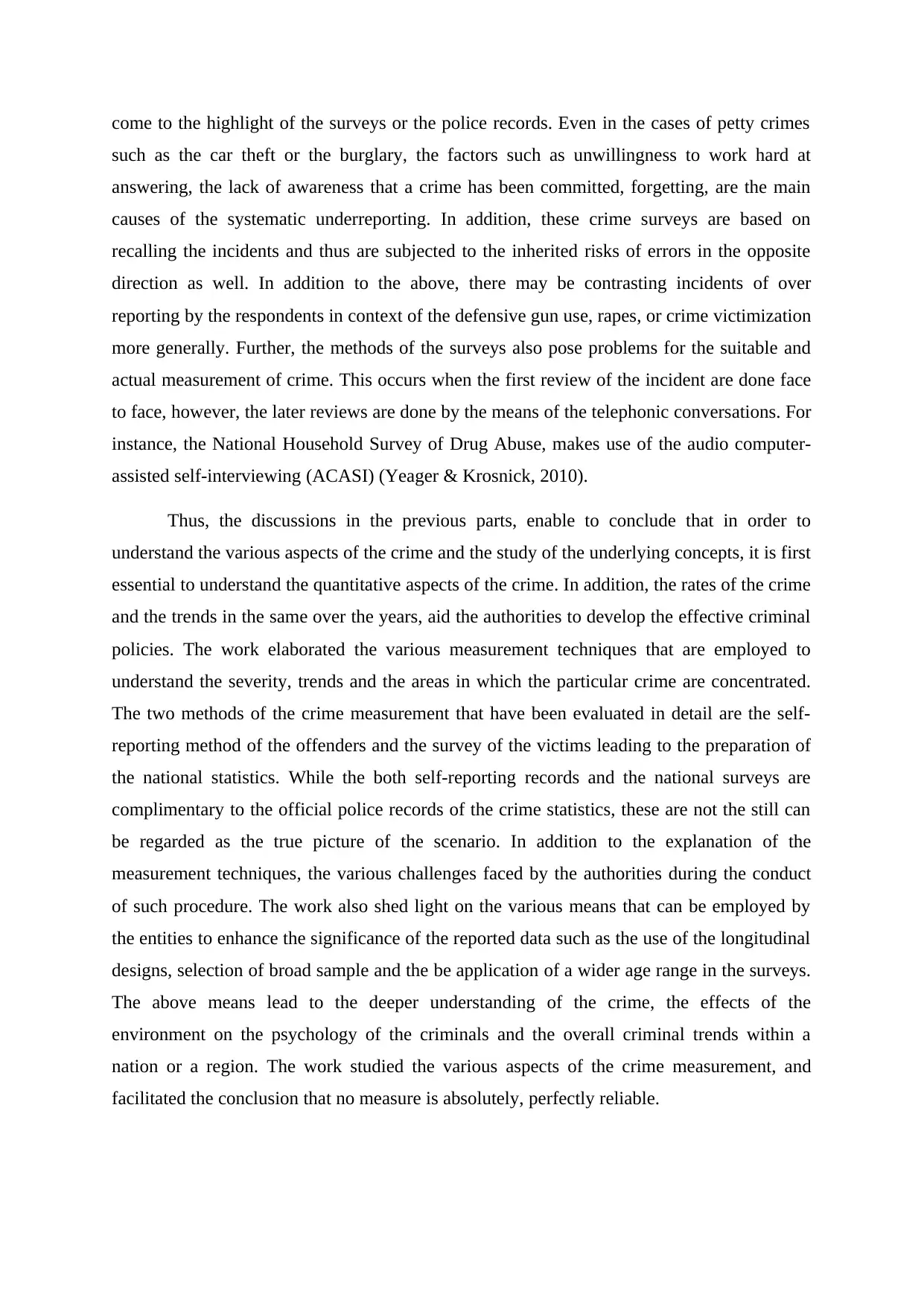
come to the highlight of the surveys or the police records. Even in the cases of petty crimes
such as the car theft or the burglary, the factors such as unwillingness to work hard at
answering, the lack of awareness that a crime has been committed, forgetting, are the main
causes of the systematic underreporting. In addition, these crime surveys are based on
recalling the incidents and thus are subjected to the inherited risks of errors in the opposite
direction as well. In addition to the above, there may be contrasting incidents of over
reporting by the respondents in context of the defensive gun use, rapes, or crime victimization
more generally. Further, the methods of the surveys also pose problems for the suitable and
actual measurement of crime. This occurs when the first review of the incident are done face
to face, however, the later reviews are done by the means of the telephonic conversations. For
instance, the National Household Survey of Drug Abuse, makes use of the audio computer-
assisted self-interviewing (ACASI) (Yeager & Krosnick, 2010).
Thus, the discussions in the previous parts, enable to conclude that in order to
understand the various aspects of the crime and the study of the underlying concepts, it is first
essential to understand the quantitative aspects of the crime. In addition, the rates of the crime
and the trends in the same over the years, aid the authorities to develop the effective criminal
policies. The work elaborated the various measurement techniques that are employed to
understand the severity, trends and the areas in which the particular crime are concentrated.
The two methods of the crime measurement that have been evaluated in detail are the self-
reporting method of the offenders and the survey of the victims leading to the preparation of
the national statistics. While the both self-reporting records and the national surveys are
complimentary to the official police records of the crime statistics, these are not the still can
be regarded as the true picture of the scenario. In addition to the explanation of the
measurement techniques, the various challenges faced by the authorities during the conduct
of such procedure. The work also shed light on the various means that can be employed by
the entities to enhance the significance of the reported data such as the use of the longitudinal
designs, selection of broad sample and the be application of a wider age range in the surveys.
The above means lead to the deeper understanding of the crime, the effects of the
environment on the psychology of the criminals and the overall criminal trends within a
nation or a region. The work studied the various aspects of the crime measurement, and
facilitated the conclusion that no measure is absolutely, perfectly reliable.
such as the car theft or the burglary, the factors such as unwillingness to work hard at
answering, the lack of awareness that a crime has been committed, forgetting, are the main
causes of the systematic underreporting. In addition, these crime surveys are based on
recalling the incidents and thus are subjected to the inherited risks of errors in the opposite
direction as well. In addition to the above, there may be contrasting incidents of over
reporting by the respondents in context of the defensive gun use, rapes, or crime victimization
more generally. Further, the methods of the surveys also pose problems for the suitable and
actual measurement of crime. This occurs when the first review of the incident are done face
to face, however, the later reviews are done by the means of the telephonic conversations. For
instance, the National Household Survey of Drug Abuse, makes use of the audio computer-
assisted self-interviewing (ACASI) (Yeager & Krosnick, 2010).
Thus, the discussions in the previous parts, enable to conclude that in order to
understand the various aspects of the crime and the study of the underlying concepts, it is first
essential to understand the quantitative aspects of the crime. In addition, the rates of the crime
and the trends in the same over the years, aid the authorities to develop the effective criminal
policies. The work elaborated the various measurement techniques that are employed to
understand the severity, trends and the areas in which the particular crime are concentrated.
The two methods of the crime measurement that have been evaluated in detail are the self-
reporting method of the offenders and the survey of the victims leading to the preparation of
the national statistics. While the both self-reporting records and the national surveys are
complimentary to the official police records of the crime statistics, these are not the still can
be regarded as the true picture of the scenario. In addition to the explanation of the
measurement techniques, the various challenges faced by the authorities during the conduct
of such procedure. The work also shed light on the various means that can be employed by
the entities to enhance the significance of the reported data such as the use of the longitudinal
designs, selection of broad sample and the be application of a wider age range in the surveys.
The above means lead to the deeper understanding of the crime, the effects of the
environment on the psychology of the criminals and the overall criminal trends within a
nation or a region. The work studied the various aspects of the crime measurement, and
facilitated the conclusion that no measure is absolutely, perfectly reliable.
⊘ This is a preview!⊘
Do you want full access?
Subscribe today to unlock all pages.

Trusted by 1+ million students worldwide
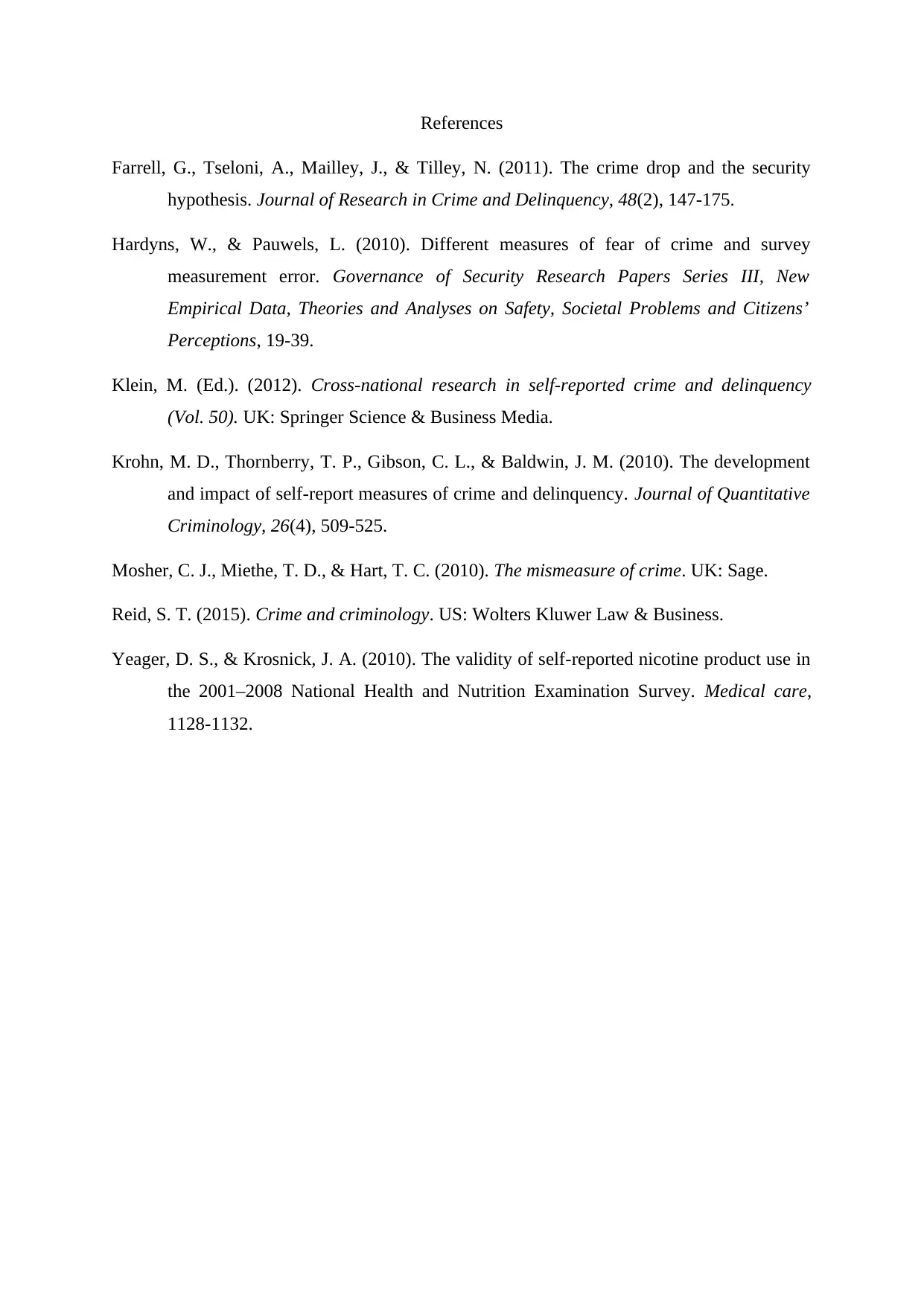
References
Farrell, G., Tseloni, A., Mailley, J., & Tilley, N. (2011). The crime drop and the security
hypothesis. Journal of Research in Crime and Delinquency, 48(2), 147-175.
Hardyns, W., & Pauwels, L. (2010). Different measures of fear of crime and survey
measurement error. Governance of Security Research Papers Series III, New
Empirical Data, Theories and Analyses on Safety, Societal Problems and Citizens’
Perceptions, 19-39.
Klein, M. (Ed.). (2012). Cross-national research in self-reported crime and delinquency
(Vol. 50). UK: Springer Science & Business Media.
Krohn, M. D., Thornberry, T. P., Gibson, C. L., & Baldwin, J. M. (2010). The development
and impact of self-report measures of crime and delinquency. Journal of Quantitative
Criminology, 26(4), 509-525.
Mosher, C. J., Miethe, T. D., & Hart, T. C. (2010). The mismeasure of crime. UK: Sage.
Reid, S. T. (2015). Crime and criminology. US: Wolters Kluwer Law & Business.
Yeager, D. S., & Krosnick, J. A. (2010). The validity of self-reported nicotine product use in
the 2001–2008 National Health and Nutrition Examination Survey. Medical care,
1128-1132.
Farrell, G., Tseloni, A., Mailley, J., & Tilley, N. (2011). The crime drop and the security
hypothesis. Journal of Research in Crime and Delinquency, 48(2), 147-175.
Hardyns, W., & Pauwels, L. (2010). Different measures of fear of crime and survey
measurement error. Governance of Security Research Papers Series III, New
Empirical Data, Theories and Analyses on Safety, Societal Problems and Citizens’
Perceptions, 19-39.
Klein, M. (Ed.). (2012). Cross-national research in self-reported crime and delinquency
(Vol. 50). UK: Springer Science & Business Media.
Krohn, M. D., Thornberry, T. P., Gibson, C. L., & Baldwin, J. M. (2010). The development
and impact of self-report measures of crime and delinquency. Journal of Quantitative
Criminology, 26(4), 509-525.
Mosher, C. J., Miethe, T. D., & Hart, T. C. (2010). The mismeasure of crime. UK: Sage.
Reid, S. T. (2015). Crime and criminology. US: Wolters Kluwer Law & Business.
Yeager, D. S., & Krosnick, J. A. (2010). The validity of self-reported nicotine product use in
the 2001–2008 National Health and Nutrition Examination Survey. Medical care,
1128-1132.
1 out of 7
Related Documents
Your All-in-One AI-Powered Toolkit for Academic Success.
+13062052269
info@desklib.com
Available 24*7 on WhatsApp / Email
![[object Object]](/_next/static/media/star-bottom.7253800d.svg)
Unlock your academic potential
Copyright © 2020–2025 A2Z Services. All Rights Reserved. Developed and managed by ZUCOL.





